Let’s face it, building new features is one of the most exciting aspects of product marketing, smashing customer expectations and consistently improving a product for users is the reason we do what we do. But how do we decide which of these features to focus on first or at all?
Prioritizing feature requests is an ongoing process for product teams, you have to work together to consider the cost of the requests, market competition, and available resources as well as considering the business objectives, it can be a tricky balancing act. Which is why we’ve put together this guide!
We’ll talk you through the points you’ll need to consider when prioritizing requests, and how to prioritize them using popular frameworks.
In this article, we'll focus on:
- What is a product feature prioritization framework?
- What to consider before using a product feature prioritization framework
- How do product marketers prioritize feature requests?
- What are the 4 Disciplines of Execution?
- What does an effective product feature prioritization framework look like?
What is a product feature prioritization framework?
A product prioritization framework helps product marketers strategize and map out their priorities when mapping the next steps for their product features.
When planned and carried out properly, a product feature prioritization framework can play a key role in helping you answer a variety of important questions, such as:
- Is your new feature bringing maximum value to your business?
- Will your customers actually benefit from your new product feature?
- Will the introduction of the product feature support business objectives and OKRs?
- Is it feasible to implement the feature within your Go-to-Market strategy (and launch it?)
What to consider before using a product feature prioritization framework
Before implementing a product feature prioritization framework and considering which features to hierarchize, there are things you need to consider.
For example, are you looking for a short-term win right now or working towards long-term growth? How do you give the input and ideas from developers, stakeholders, sales, and the rest of the product team the consideration they deserve?
Take a look at the following:
Profit
Will this feature make a profit? How much will it cost to build vs how much profit will it yield?
It sounds obvious, but the initial reaction to focus on the feature which costs the least to build isn’t always the right one. Don’t lose sight of the bigger picture or the most attractive profit margin.
Cost
How much will it cost to build this feature? If the estimated profit is set to be huge and the cost is low by all means carry on.
However, if it’s just too expensive to build right now, it may not be worth the effort (even if it’s set to make a handsome profit).
Resources
Do you have the time? The availability? The numbers to make this feature happen?
You might have a feature that you’ve estimated will take around 10 weeks to complete, but Christmas is around the corner, will you still have the same amount of manpower then?
If the answer is no, focus on the feature that takes half the amount of time.
This sort of forward-thinking can save you a world of pain in terms of bugs, delays, and technical issues in the final stages, with little to no team members available to help.
Technical risk
We all know problems can arise in the development phase, delays, technical hitches, added costs.
It’s important you weigh up a feature’s risk and how likely it is to put a strain on the development team, the business’s bank account, and the estimated time frame.
Market risk
If you can’t accurately estimate profit, you have to estimate the market risk.
Throwing together a social media app might take the least time, but there are already a lot of really great ones out there, and pretty much anyone with the knowledge can build one, which makes the market risk high.
However, if you built an app that read minds (a stretch we know) it would take much longer than a few days to build, but there certainly wouldn’t be another on the market.
Team value
Nobody knows the product better than the team who built it. Ask them to use the product in real-life scenarios for a set amount of time and see what value they place on the new feature.
If the value’s high it could help you decide whether or not it’s a top priority right now.
How do product marketers prioritize feature requests?
Now we know what we’re dealing with in terms of risk, value, money, and time, how do product marketers, taking into account all of these factors, prioritize their requests?
This is a question we posed to our Slack community and unsurprisingly, we got some really interesting responses in return. Here are two of our faves.
“I’d recommend setting out three pillars for your group (whether sales, marketing, etc.) Your three biggest initiatives for the remainder of the year. Then, prioritize requests based on how and by how much it will impact one of those pillars. If you can’t immediately determine a metric or how there will be impact, then you know it’s a low priority request.”
Shawn Pillow, Director of Sales Enablement, Granicus
"Set the right expectations upfront, product marketing should be experts in the market, industry, and roadmap whereas the individual sales rep or client success manager is the expert in the deal and client relationship, keeping this in mind ensures that any one-off requests for mission-critical asks are the exception rather than the rule.
"Get stakeholder engagement for strategic projects by surveying them to find the most pervasive business problems and obstacles, quantify their impact, and build programs that have tangible and measurable results.
"This way you can protect the time required to address these strategic problems. I like the way the 4 Disciplines of Execution lays it out - you need to dedicate 20% of your time to strategic work that will not get done unless you carve out time to focus on it and the remaining 80% is "whirlwind" business as usual in the day to day running of your role.”
Louise Dunne, B2B SaaS Product Marketing Manager & Enablement professional
Speaking of the 4 Disciplines of Execution, we thought it would be helpful to summarise them in this article.
Although it’s fair to be suspicious of advice that falls under the general umbrella of business, these disciplines are actually really helpful in ensuring that the most important work gets done.
What are the 4 Disciplines of Execution?
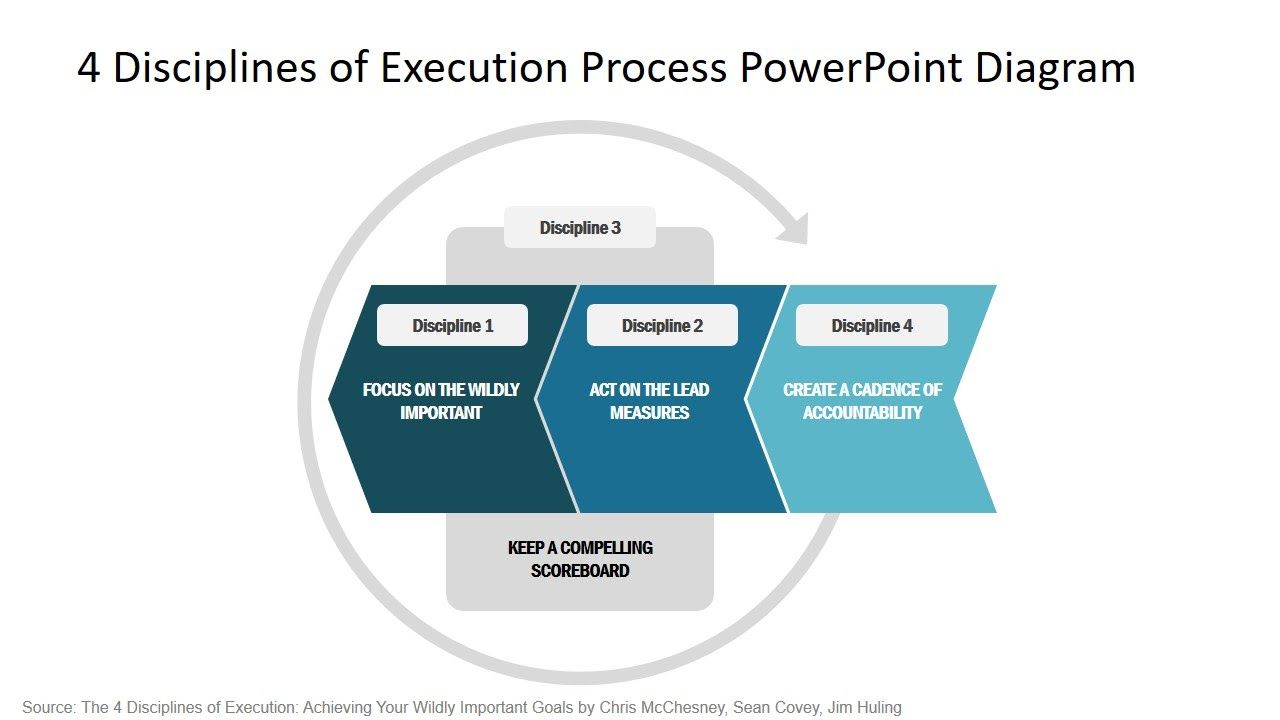
1) Focus on the wildly important
As the saying goes, ‘focus on less to achieve more.’ Choose one really important goal, this is now referred to as your ‘Wildly Important Goal’ or WIG.
To choose a WIG, brainstorm all possible goals with your team and rank the choices by impact to narrow them down.
Now, look at the shortlist and test each WIG for how it will affect the overall goals of the business, how it can be measured effectively, and whether or not the team has control over the results.
2) Act on the lead measures
Your success will be based on two kinds of measures, Lag and Lead.
Lag measures track the success of your WIG, they include things like revenue, profit, quality, and customer satisfaction, the main things you worry about as a business basically.
They’re called Lags because, by the time you see them, the action that drove them has finished, they’re history, there’s nothing you can do to fix or improve them.
Lead measures track the actions that drive the lag measure and predict the success of the lag measure. A simple example of this would be weightloss, which lead measures will lead to weight loss? Diet and exercise! A set of actions we have direct influence over that we know will help us reach our desired goal.
As a team, choose your own lead measures by selecting activities that will have the most impact on achieving the WIG.
3) Keep a compelling scoreboard
People play with more purpose when they’re keeping score - it’s a fact. A visible scoreboard helps the team work out how to move forward, it keeps people motivated and engaged, especially when they’re winning. The scoreboard should be simple and visible and show both lead and lag measures.
4) Create a cadence of accountability
Each team responsible for a WIG should take part in a weekly process that highlights success and looks at failures, planning how to correct them as necessary.
The cadence of accountability is about frequent and regular meetings that focus on your WIG. In that meeting, the team holds each other accountable for their commitment to hitting the common goal.
“Accountability breeds response-ability.”
Dr. Stephen R. Covey
What does an effective product feature prioritization framework look like?
According to the team at Roadmunk, “Good product prioritization frameworks allow you to silence the voice of the loudest person in the room using quantitative rankings, charts, and matrices with values that are directly tied to your customer feedback and product strategy.”
Below we’re going to list popular and relevant examples of a product feature prioritization framework:
What is the RICE framework?
Intercom’s internal scoring system for prioritizing ideas, RICE allows product teams to prioritize each feature against four factors: Reach, Impact, Confidence, and Effort. Here’s a breakdown courtesy of Roadmunk.
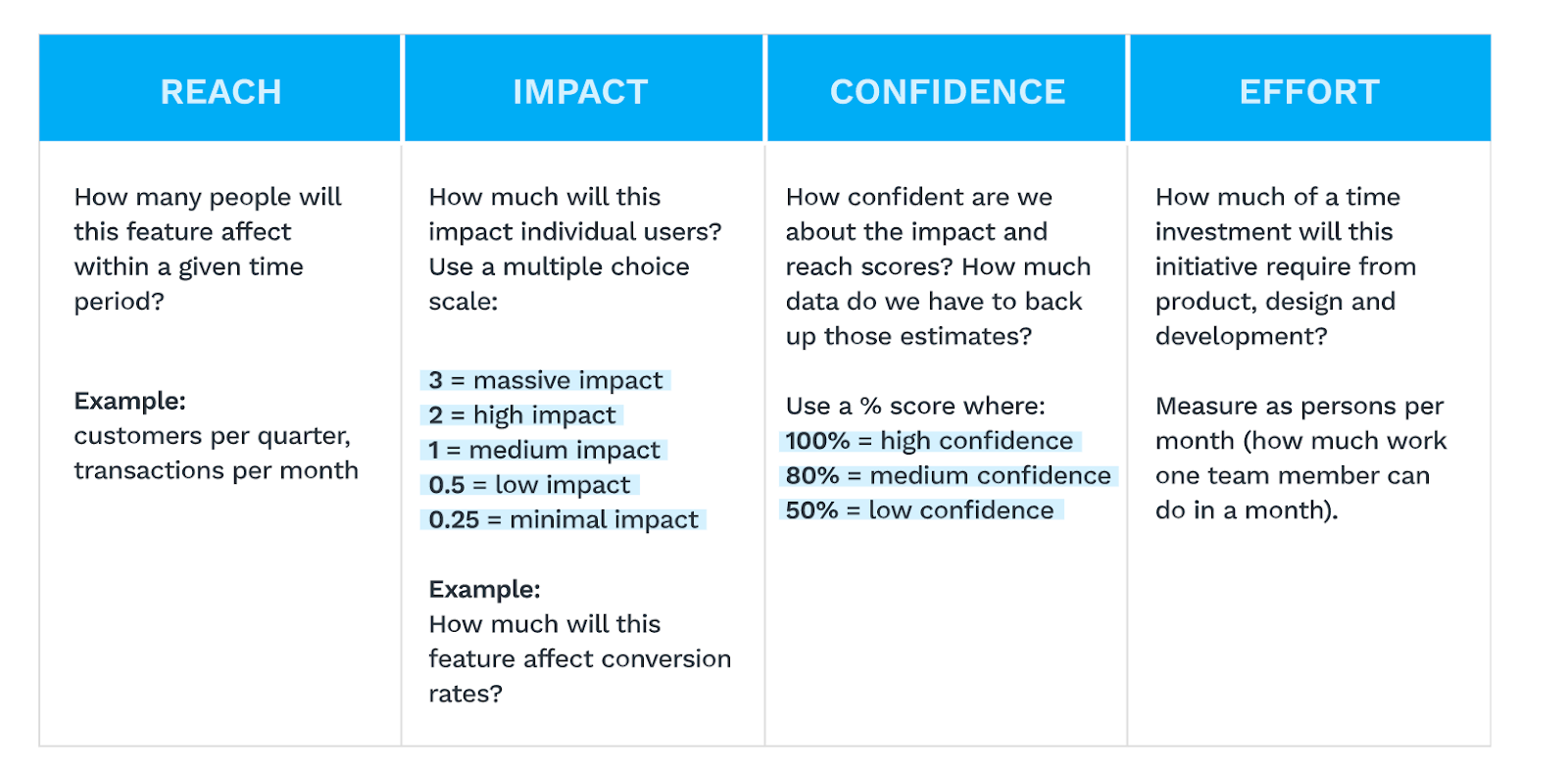
The numbers in each column are then turned into one overall score using the formula Reach x Impact x Impact divided by effort.
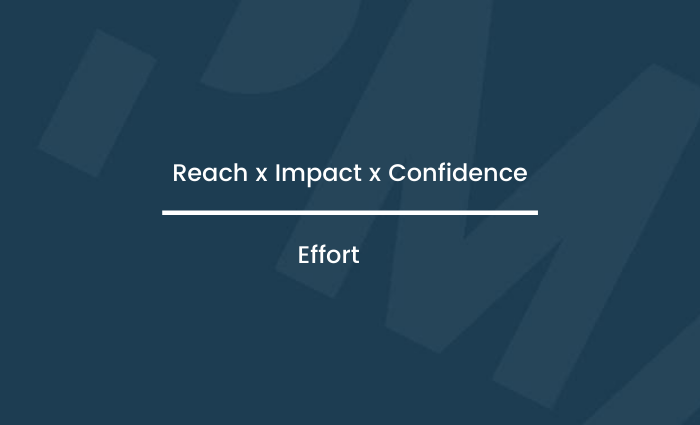
This number enables you to see how much impact the effort is likely to yield, a pretty important insight to consider when prioritizing requests.
After using this formula on every feature on your list, you’ll get your final RICE score, which you can then use to rank your features by priority. Here’s an example:
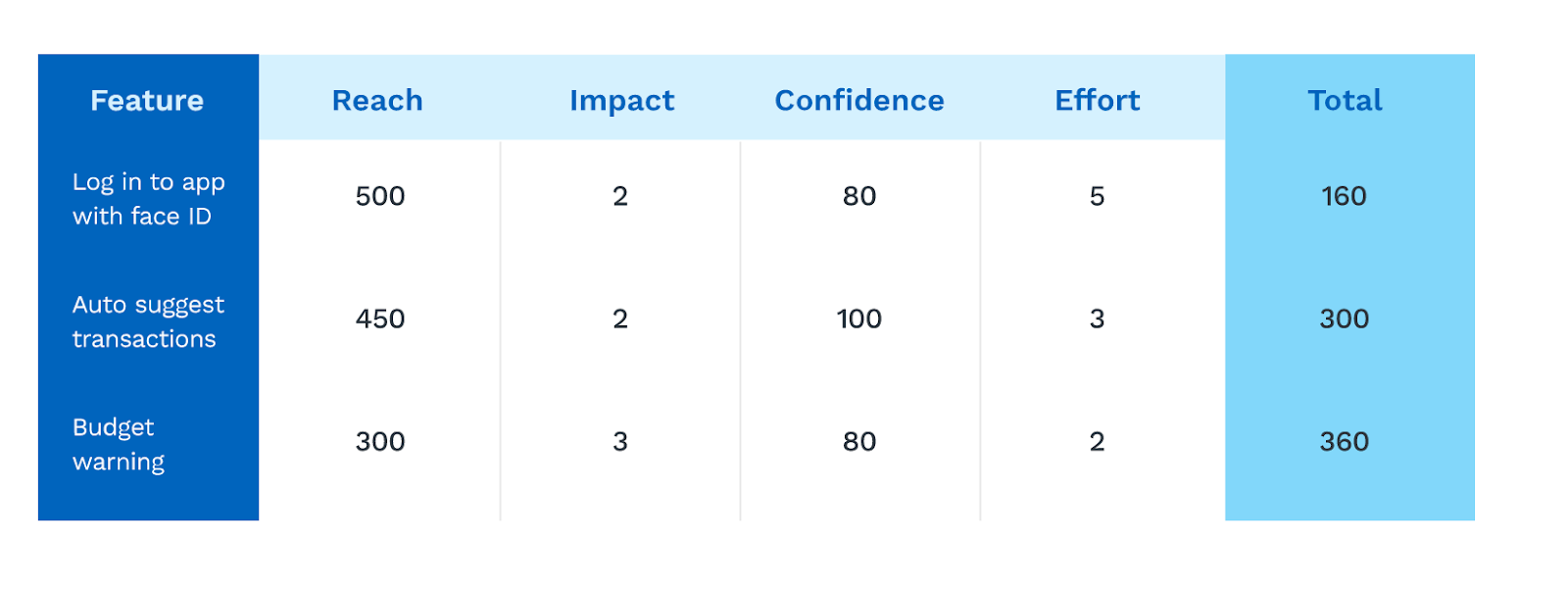
What is the Kano model?
With the Kano model, each potential feature is broken down into different categories along with the user’s emotional response:
Attractive Needs: These features trigger satisfaction and delight, but users aren’t too bothered if the feature isn’t included.
Performance Needs: These features trigger delight or dissatisfaction when they’re not present.
Basic Needs: These are the features your customer expects to be there. Not including them is dissatisfying.
The vertical axis shows us the level of customer satisfaction, which ranges from needs not being met on the left, to the needs being fully met on the right.
To gain this customer insight you’ll need to develop a Kano questionnaire so you can ask your users how they’d feel about gaining or losing a particular feature.
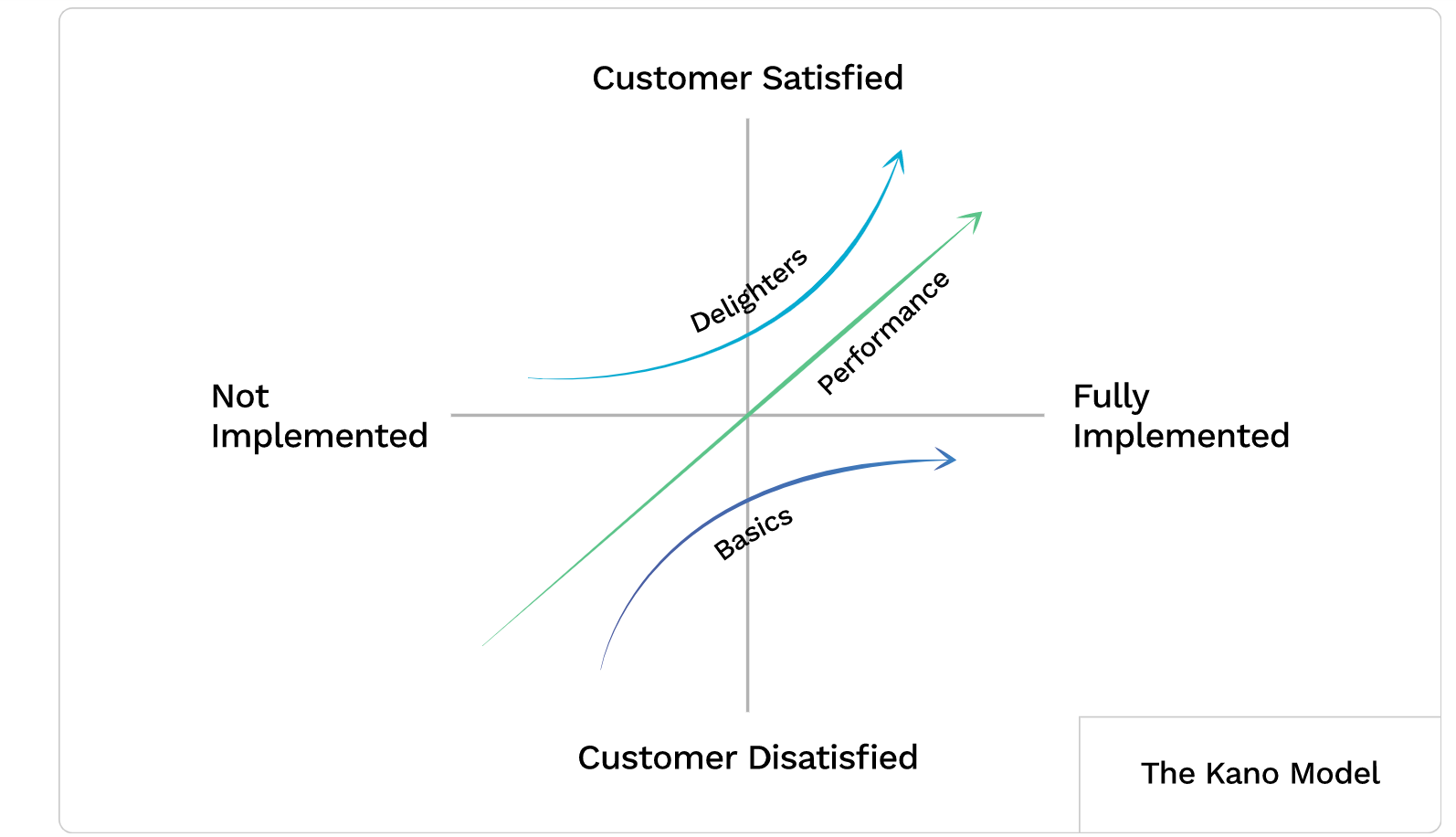
What is the MoSCoW method?
The MoSCoW method stands for Must-Have, Should-Have, Could-Have, and Won’t-Have features.
Must-Have: These are the features that have to be there for the product to be functional. They’re non-negotiable, if one of these features isn’t present, the product can’t be launched at all.
Should-Have: These features might be important to deliver, but they’re not time-sensitive.
Could-Have: This is a non-essential feature treated as a bonus, it might improve customer satisfaction but it won’t have a huge impact if it’s not featured at all.
Won’t-Have: You might consider these features for future releases but they rank pretty low priority-wise.
The MoSCoW model is pretty dynamic and allows you the room to evolve your priorities, it’s also an easy and intuitive way of showcasing priorities to the team and your users.
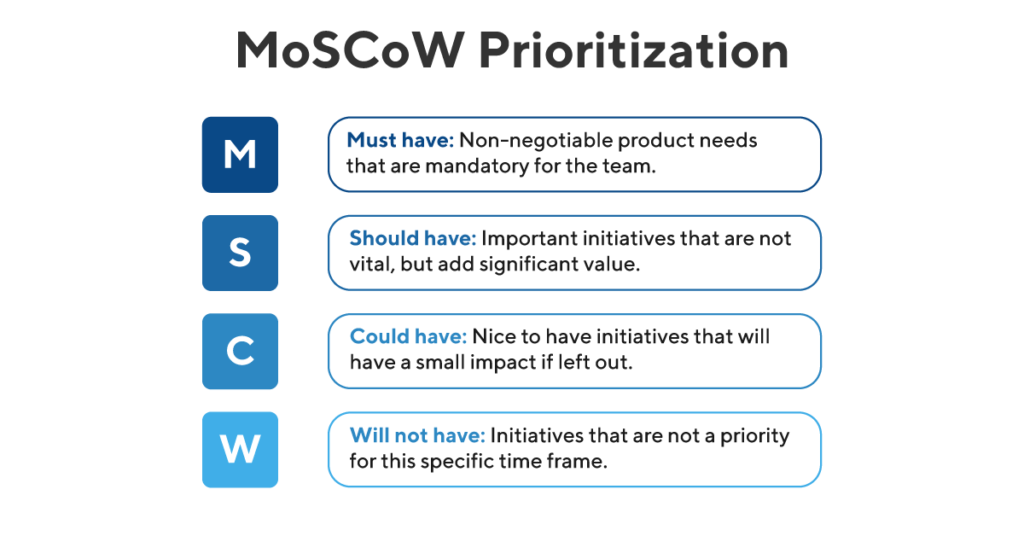
What is opportunity scoring?
This method comes from Anthony Ulwick’s Outcome-Driven Innovation concept. His theory is that customers buy products and services to get certain jobs done.
Mr Ulwick argues that customers aren’t very good at coming up with solutions to their problems, but their feedback is vital. This feedback is what you will utilize to come up with the desired outcomes for a feature.
Opportunity scoring uses a graph to measure and rank opportunities, as the team makes a list of ideal outcomes, they ask users the following questions:
- How important is this outcome/feature?
- Can you rank their importance?
- How satisfied are you with the existing solutions?
Once you plot their answers on the chart (like below) you’ll be able to see the features that are most important to your users, but currently have low satisfaction scores within the product. These are the features to prioritize.
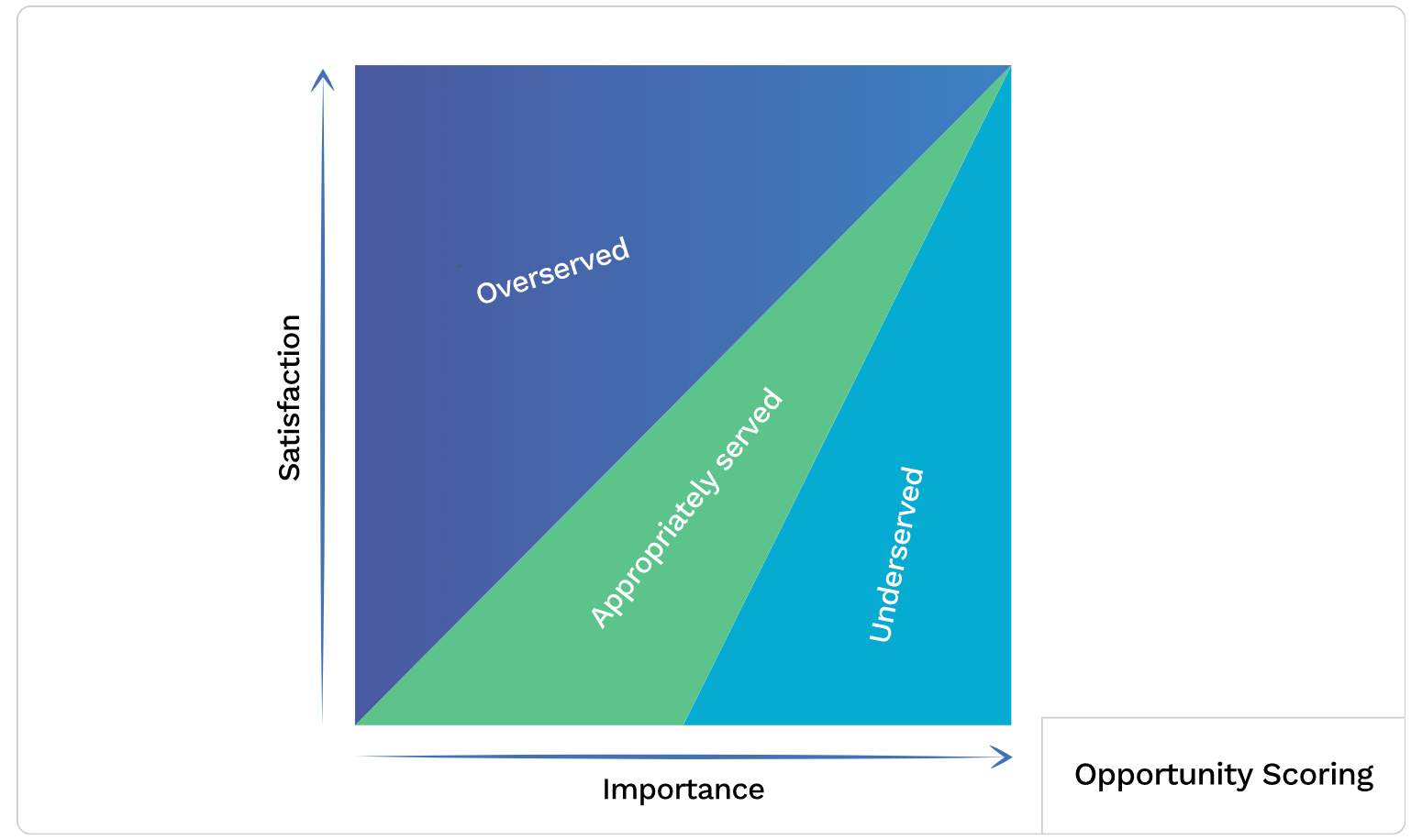
Prioritization frameworks are an excellent tool to get product teams, stakeholders and developers on the same page in terms of feature prioritization, but they definitely shouldn’t replace conversations with actual human beings.
Continue conversations with your users, feedback their gripes and compliments, and above all listen. Customer needs change regularly and so should your priorities; take the time to regularly reassess them and you’ll find your customer satisfaction rate rockets.
During her presentation at the Product Marketing Summit, Chicago, Kristina Volovich, Product Marketing Manager, Audible for Business, Amazon, reaffirmed the value of customer and market feedback, explaining how to incorporate the voice of the customer into your product marketing strategy.
What is story mapping?
Story mapping puts the focus on your users instead of your stakeholders. Using the horizontal line you create a series of categories representing each stage of your user’s journey through your product, from sign-up to using specific features.
You then place these tasks, from top to bottom in order of importance. This allows you to prioritize the order of the features you’ll work on in the future. At the end of the process, you draw a line across all the stories to divide them into releases and sprints.



















 Follow us on LinkedIn
Follow us on LinkedIn



.svg?v=4c397528de)